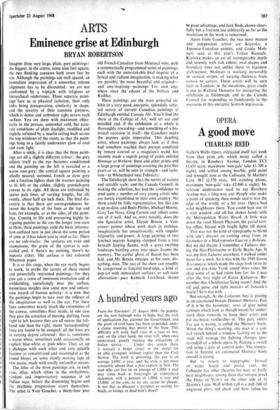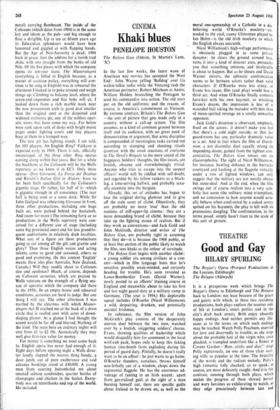A good move
OPERA CHARLES REID
Sadler's Wells Opera extricated itself last week from that prim job, which many called a theatre, in Rosebery Avenue, London EC1 (1,497 seats; maximum 'non-gala' take £1,700 a night), and settled among marble, gold paint and wrought iron at the Coliseum, St Martin's Lane, WI (2,370 seats, 304 standing places, maximum 'non-gala' take £2,400 a night). In- veterate understaters used to say Rosebery Avenue was a long way out. People who make a point of speaking their minds said it was the edge of the world, or a bit over. Opera had solid neighbours there. You could lean out of a stair window and all but shakes hands with the Metropolitan Water Board. A little way down the road Mount Pleasant, the postal sort- ing office, blazed with bright lights till dawn.
This was not the kind of topography to blend with one's dreams on coming away from an ldomeneo or a Makropoulos Case or a Boheme. But we did dream. I remember a Tabarro dur- ing the Neo-Pleistocene or Early Baylis Age. It was my first Tabarro anywhere. I walked under buses for a week. So it was with the 1949 Simon Boccanegra, which made the stage look twice its size and pre-Aida Verdi sound three times the chap some of us had taken him for. So it was after the first night of Katya Kabanova. Re- member that Chekhovian living room? And the rill and pulse and tight mosaics of Janacek's music? §o it was with. . . .
But enough. At the Coliseum they're putting in an automated Instant Dimmer Memory. Part of It is in the basement: rows of grey metal cabinets which look as though meant for under- sized shop stewards to hang their coats and put tea-break sandwiches in. This part, unless I've got it wrong, is called the Memory Store. When the thing's working, one man at a con- trol switch behind a window looking on to the stage will manage the lighting changes (pre- recorded) of a whole opera by flicking a switch and using a pair of control nobs. The tempta- tion to become an automated Memory Store oneself is strong.
But to return to topography. Instead of water board and postal vans, the Coliseum has other theatres for near or fairly near neighbours, among them that antique jewel the Duke of York's on the other side of St Martin's Lane. Well within call is a pub full of engraved glass, red plush and bare ladies (in
metal) carrying flambeaux. The inside of the Coliseum (which dates from 1904) is in the same key and idiom as the pub—and big enough to float a dirigible. Up to ten or fifteen years ago its Edwardian splendours would have been lamented and giggled at with flapping hands. But the Age of Neo-Austerity is dead; 1904 back in grace. Just the address for a lavish trad Aida, with sets straight from the banks of old Nile. Of the five pieces with which the company opens its ten-year lease, The Mastersingers (everything is billed in English because, as a matter of castiron policy, everything will con- tinue to be sung in English) was in rehearsal the afternoon I looked in to poke around and weigh things up. Climbing to balcony level, where the seven-and-sixpennies and five bobs will sit, I looked down from a rich marble nook near the new proscenium arch (a good deal smaller than the original one) at the deepened and widened orchestra pit, one of the noblest oper- atic views that have come my way. Far below were rank upon rank of desks with bright music pages under lighting cowls and tiny players busy at them in a tranquil way.
The new pit has lighting stands, I am told, for 103 players. An English Ring? Valkyrie is expected early in 1969. There is talk, officially encouraged, of the three other Ring operas coming along within five years. But for a while the backbone at the Coliseum will be the Wells repertory as we knew it in EC'. Only three operas—Don Giovanni, La Forza del Destino and Rossini's Italian Girl in Algiers—have so far been built specifically for the Coliseum's gigantic stage. Or rather, for half of it—which is gigantic enough in all conscience. (The rear half is being used as a scene dock. While Sir John Gielgud was rehearsing Giovanni in front, three other productions, including one huge built set, were parked behind the backcloth. And room for more.) The remaining forty or so productions in the Wells repertory were con- ceived for a different size of stage (including some big provincial ones) and for less grandilo- quent auditoriums in relatively drab localities. What sort of a figure are these productions going to cut among all the gilt and granite and glory? Then those English voices and acting talents, some so good and seasoned, others so good and promising. (In this context 'English' means these isles plus Australia, New Zealand, Canada.) Will they readily shoot to Coliseum size and opulence? Much, of course, depends on Coliseum acoustics, which are praised by Wells veterans on the strength of a flying sea- son of operetta which the company did there in the 1950s. In an empty house and rehearsal conditions, acoustics are hard to judge. But one thing .I will say. The other afternoon I was startled by the clearness with which Master- singers Act II reached me at the back of a dress circle that is roofed over with acres of down- sloping plaster. At a glance I had thought the sound would be far off and blurred. Nothing of the kind. The seats here on ordinary nights will cost from £1 to £2 10s. Acoustically they may well give first-rate value for money.
For money is something we must come back to. English opera has never had enough of it. Eight days before opening night a Wells direc- tor loudly slapped the nearest thing handy, a door jamb, out of pure exuberance and said advance bookings stood at £40,000. A young man from catering buttonholed me about smoked salmon sandwiches, quarter bottles of champagne and chicken in the basket. Every- body was on tenterhooks and top of the world. Me included.



































 Previous page
Previous page